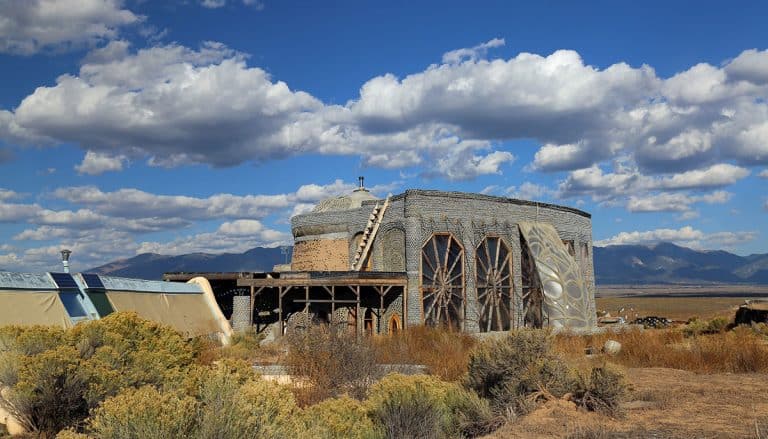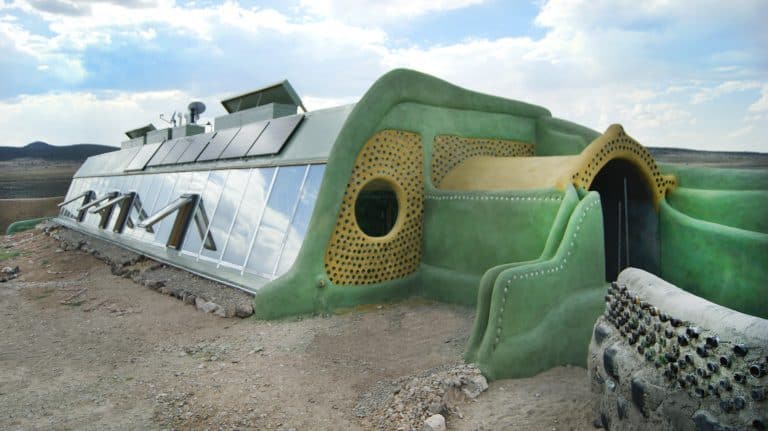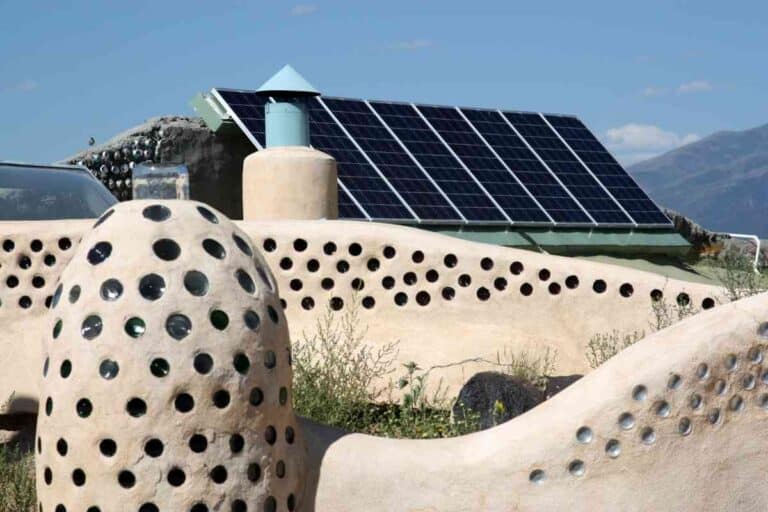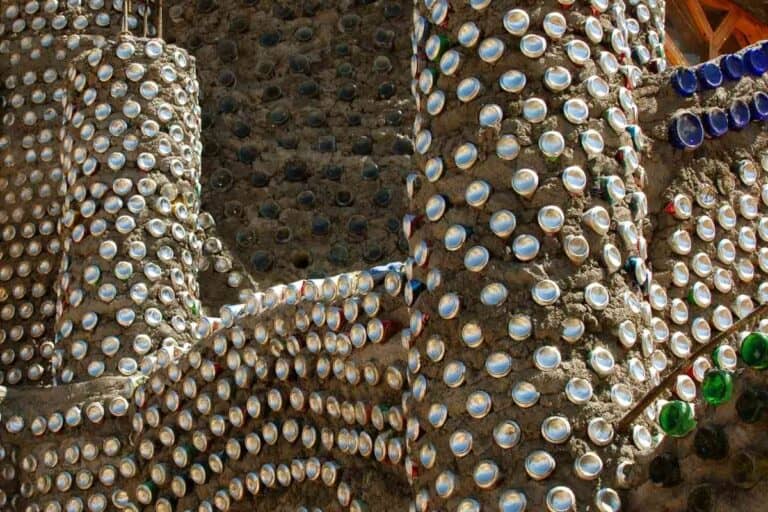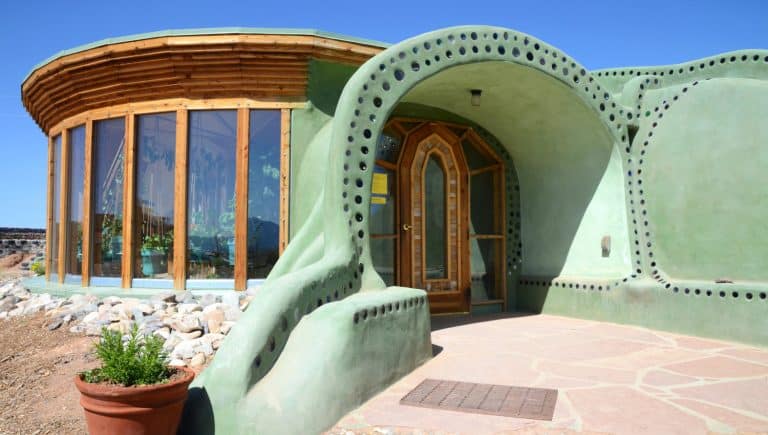This is How Earthships Treat Sewage
One of the defining features of an Earthship is that the sewage is contained and treated on site. This is just one step in the process that helps establish the cycle of sustainability and limited waste that characterizes Earthships. But how do Earthships handle the sewage produced in the home?
In traditional Earthships, sewage water is sent to rubber-lined outdoor plant containers to water plants and small trees. However, this is done in Earthships through the use of a completely contained sewage treatment system.
To find out more about the steps of this process, as well as how Earthships acquire water and recycle it, read on below.
How Earthships Treat Sewage
Most of us rarely think about how much water we waste in our homes. When we wash our dishes, brush our teeth, or go to the bathroom, we flush away gallons of water over the course of the day.
In order to be completely sustainable and without waste, Earthships have to use and recycle all water used. That means that the water most of us would normally let run down the drain and into the sewer needs to be contained and reused.
Some water in Earthships can be easily reused without treatment, but sewage water is not in this category. Most Earthships will capture the sewage water and shunt it to outdoor plantings, usually contained in rubber-lined planters. However, this method requires treating sewage water before repurposing it.
Sewage water, sometimes referred to as blackwater, needs to be treated before being used because it can contain bacteria, particles of food and rubbish, and dangerous pathogens.
An Earthship’s water system can be broken down into three main parts:
- The water catch
- A system to treat and reuse greywater
- A system to treat blackwater
In the next few sections, we will explain these components and how they all work together in a system to allow the Earthships to be completely self-sustaining and manage to treat and reuse sewage water created.
The Water Catch Captures Every Drop of Water Possible
In order to be sustainable and acquire enough freshwater to function, Earthships are designed to take advantage of any available water in the environment and contain it. Before an Earthship can even begin to produce sewage, it needs to have fresh water. This water is obtained through several unique design features.
First of all, the roof of an Earthship is specially designed to collect and channel water. The materials used to build the roof are typically those that will not contaminate the water, and the roof is shaped in a way that water will be collected into a cistern. According to Earthshipglobal.com, “every inch of rain collected from a square foot of roof equals ⅔ of a gallon of water.”
Depending on the size of the roof and the amount of rainfall in a year, you can, therefore, estimate how much water can be potentially collected from the environment. If the home is in a colder climate, snowfall can be collected as water as it melts, and the roof is orientated so the snow will not evaporate before melting.
The rain and meltwater are collected and drained into a cistern. This cistern is often fitted with filters to eliminate any potential debris and are often made of plastic or cement with acrylic coating. The cistern has a pump that will pull water from the cistern into the house when needed. The water is passed through several additional filters to ensure purity before use.
Water that will be intended for consumption or cooking goes through extra filtration processes to make sure it is safe to drink. A solar-powered hot water heater system can also heat water, so it’s available for warm showers as well as doing laundry or dishes.
Greywater is Treated and Recycled
Greywater is the term for water that has already been through one use cycle in the home but has not come in contact with feces. This means it includes the water you use to bathe, cook, do laundry, wash dishes, and brush your teeth. It may contain some particulates or household cleaners and appear dirty, but it is generally considered safe for irrigation purposes.
In Earthships, greywater is collected and piped to internal planters. These internal planters often contain edible plants that help produce food to support the sustainability efforts of the Earthship. These plants essentially treat the greywater by letting it filter through their roots and soil, using up nutrients and absorbing some of the water along the way.
The greywater may be recycled a few times through these indoor plants before it is collected in a small well. At this point, the greywater in the well is pumped on demand to the toilet whenever it is needed to flush. After the greywater has been used in the toilet, it has come in contact with fecal matter and is now considered blackwater.
In a normal house, the water you flush from the toilet would be sent through pipes to a septic tank or drain to the city’s sewer lines. Since Earthships are meant to be completely self-contained, the blackwater must be treated on-site, rather than sending it off to a city sewage treatment center.
Treating Blackwater in an Earthship
In conventional homes, forty percent of the water used is for flushing toilets. This is, therefore, a huge aspect of wasted water in most homes. Earthships address this major area of waste in a fairly simple fashion.
Once the water in an Earthship has been used in a toilet, it is now sent to a septic tank. This septic tank then drains into surrounding rubber-lined containers. These rubber-lined containers hold the exterior plants surrounding the Earthship. These plants are usually ornamental, including flowers and small trees and shrubs. Blackwater should not be used to water a food-producing garden.
The septic tank usually is divided into several chambers that help break down the sludge and debris of blackwater. We’ll discuss that in more detail in the next section.
By the time the blackwater has flowed through the soil and root system of these plants, any harmful elements have been filtered out, and it is safe to drain back into the groundwater supply.
A Closer Look at Blackwater Recycling Systems
While not all Earthships utilize the same system of treating sewage, let’s take a closer look at the general type of blackwater recycling system that is often used. Overall, blackwater filtration consists of five basic steps:
- Primary treatment tank. The first stop for blackwater is a primary treatment tank. After the blackwater is flushed from the toilet, it runs into this tank by a series of pipes.
This primary tank has an established colony of helpful bacteria that helps break down large particles of the sewage. The blackwater sits in this tank for 24 hours while the bacteria does its work before moving to the next treatment stage.
- Secondary treatment tank: After 24 hours in the primary treatment tank, the blackwater is pumped into the secondary treatment tank. This tank has three separate chambers to help continue the process of treatment. Each chamber has a different role and contributes to treating the sewage.
- Aeration stage: The first portion of the secondary treatment tank is a chamber that encourages aeration of the blackwater. Water and air are added to the tank at specific times, and this mixes up the blackwater. The bacteria in the tank continue to break down components of the blackwater during this churning process.
- Sludge settling stage: In the next chamber of the secondary treatment tank, the blackwater is shunted into a container where more bacteria continue to break down the sludge.
The partially treated water moves to the surface of the chamber while the thicker sludge and debris settles down to the bottom of the chamber. The bacteria continue to digest this sludge and eventually convert it into more partially treated water.
- Irrigation stage: This final step of the process is when the partially treated water in the top of the chamber in the sludge settling stage is pumped into an irrigation chamber.
In this stage, the partially treated water is chlorinated and clarified. After this step, the water is pumped out to water the surrounding landscape and gardens. Even after treatment, blackwater should not be used to water food crops or used as drinking water.
Benefits of Recycling Blackwater
Earthships recycle blackwater to provide water to the surrounding landscape features, such as grass lawns and decorative flowers and trees.
However, watering these plants isn’t the only benefit of recycling blackwater. There are a number of advantages to recycling blackwater in your home.
- Conserves water: perhaps most obviously, recycling blackwater helps conserve water, so you don’t have to waste freshwater to water plants and lawns.
- Conserves energy: when blackwater is sent to a sewage treatment plant, it takes a lot of resources to decontaminate and clean the water. It requires chemical treatments and a lot of energy. By letting blackwater be naturally filtered through plants to remove the bacteria and pathogens, it consumes way less energy and also is less expensive.
- Protects the environment: since the blackwater recycling system used in Earthships is very well controlled and contained, there is less of a chance of the blackwater leeching into freshwater sources and contaminating it.
- Less need for fertilizer: since blackwater is naturally rich in nutrients, the plants being watered by it do not need any additional supplementation with fertilizer. Since many fertilizers contain chemicals and potentially harmful components, using blackwater as a natural source of nutrients is less toxic to the environment.
The Downsides of Recycling Blackwater
Overall, recycling blackwater is advantageous, and there are many reasons to implement it in your home, even if you don’t have an Earthship. However, there are a few downsides that are important to take into consideration if you are contemplating implementing blackwater recycling in your home.
- Expense: because of their novelty, blackwater recycling systems are expensive to install and maintain. If something needs repair, it can also be difficult to find someone who knows how to service these systems, and the repair cost may be high.
- More frequent maintenance: compared to traditional sewage systems, blackwater recycling systems typically require more regularly scheduled maintenance. For most systems, maintenance is needed, on average, every three months by the company that installed the system.
- Odor: occasionally, those with a blackwater recycling system complain that they can smell the sewage all the time.
How Earthships Use Greywater
As mentioned, greywater is the term used to refer to any water that has been used at least once in your home but has not come into contact with any fecal matter.
While it may have particles of dirt, grease, food, and just look generally dirty (hence the name greywater,) it is still considered safe to use for irrigation. However, it should not be added to rivers or lakes because it could potentially contaminate these freshwater sources.
In Earthships, the goal is completely self-contained efficiency with absolutely no waste. Therefore, greywater is collected so it can be repurposed rather than wastefully flushed away. Most commonly, this greywater is pumped to water interior plant fixtures.
These plants are frequently part of food-producing gardens, so the greywater can help promote the cycle of sustainability by providing the Earthship with a consistent source of food.
Greywater has natural nutrients that promote the growth of these indoor gardens, eliminating the need for any additional fertilizers or supplements. Unlike blackwater, greywater is safe to use for indoor gardens and food-producing crops.
Once the greywater has filtered through this plant system, any remaining water is collected again. This water is then pumped, on-demand, to the toilet tank whenever someone flushes. This used water is then considered blackwater and moves on to the blackwater recycling treatment process discussed earlier.
In Earthships, the water, therefore, has a long journey. After being harvested from the roof collection system, the water is used four times in total. This cycle of ensuring every single drop is conserved and reused is the reason why Earthships are able to function without needing to draw any additional water from municipal water supplies or from the ground.
Even in areas of low rainfall, the efficiency of Earthships makes sure every drop is used to its full potential.
Earthships Use Greywater to Produce Food
As mentioned above, Earthships recycle greywater and blackwater in order to water plants that are on the premises.
Inside the home, greywater is pumped into gardens that produce delicious organic food. These gardens are one of the newer ideas implemented into the Earthship design and help to make these homes truly self-sufficient.
These gardens frequently utilize hydroponic planters in order to take advantage of vertical growing space, and feature arrangements of food-producing plants and herbs that have been specifically selected to thrive within the Earthship. According to Earthshipglobal.com, these plants usually include:
- Herbs
- Peppers
- Tomatoes
- Kale
- Beets
- Cucumbers
These gardens provide fresh, organic produce to supply a food source to inhabitants of the Earthship. More recently, Earthship designs have started to incorporate aqua-botanical systems.
These systems are hydroponic-based, but the containers of water also include live fish. These fish feed on the nutrients provided by the plants and greywater supply, and in return, help to fertilize the plants and grow larger, more productive crops.
The Guiding Principles of Earthship Design
Michael Reynolds first conceived the idea of Earthships in the 1970s. These homes were built to address what he considered to be the “6 human needs for a harmonious life on earth.” These six needs include the following:
- Food
- Energy
- Clean water
- Shelter
- Garbage management
- Sewage treatment
The treatment of sewage is thus a major design consideration for Earthships, and a lot of planning and effort went into making it efficient and sustainable. This system also interplays with other needs addressed in the house, including providing food and acquiring clean water. By understanding these needs, it becomes even more apparent how important it is to have a contained and environmentally-friendly way to address sewage treatment.
While not everyone may want to live in an Earthship, these guiding principles can help us determine what is important in our own homes and adjust our lives accordingly to try to address these universal needs better.
Final Thoughts
Most conventional homes waste a lot of water. For example, forty percent of the water we use is just for flushing toilets. Once the water in our home goes down the drain, we rarely pay it a second thought.
The water is shunted away from our home and drained into septic tanks or city sewer lines, and we don’t pay any attention to how much we use. We often take a consistent supply of water for granted.
However, when you stop to think about it, we could truly conserve much more water and live more efficiently if we adopted systems of treating and recycling at least a portion of this wastewater. Earthships have taken the all-or-nothing approach, completely self-containing the process of treating greywater and blackwater and making sure every single drop of water is used efficiently.
Earthships offer an ideal solution to water conservation, as well as serving as a model for a completely self-sustaining home that has a very minimal impact upon the environment. Whether you’re looking to make the jump to full-scale sustainability or just looking to lessen your impact on the environment, studying how Earthships process sewage can give you a great insight into how you can implement these systems in your own life.

